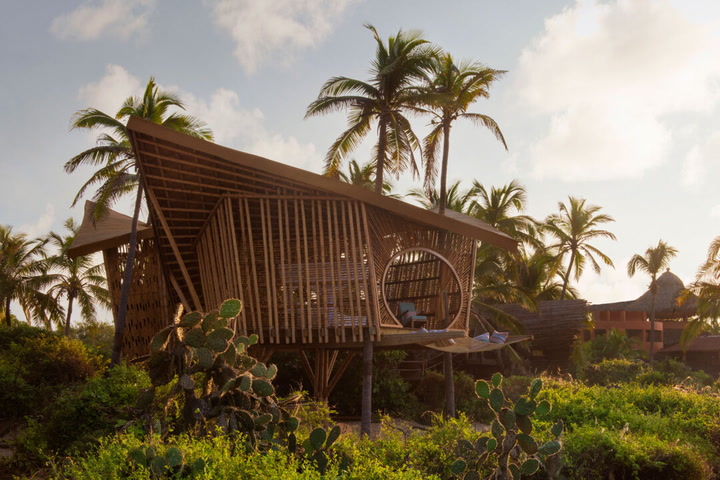Travelers tend to arrive in a destination with a packed itinerary; however, as I found out, the magic at Mexico’s Playa Viva eco-resort happens in the moments that are unplanned.
Travelers, even the most seasoned, are not guaranteed extraordinary experiences on every journey they take. Some places, however, feel primed for wonder. Taking up residence in a newly constructed bamboo tree house designed to mimic the prismatic mobula ray migration in the Pacific Ocean is a perfect example. This two-story marvel is part of Playa Viva, an off-the-grid regenerative resort near Zihuatanejo, Mexico. At its heart, it is a place for discovery, not itineraries.

We arrived late, under starlight, following oceanfront paths marked by a solar-powered amber glow (with black lights to scope out scorpions), and slipped into bed beneath a mosquito net since our fantastical beach fort had only two walls. Mother Nature’s sound machine thundered as we drifted into a natural blue noise-induced sleep.

“Peekaboo!” my husband whispered hours later as I lay awestruck in the webbed hammock suspended from the open face of our tree house, watching what appeared like old-school television static — slivers of a garnet moon wiggling in and out of focus behind Earth’s shadow. This dance, the longest partial lunar eclipse since 1440, intermittently created a divine halo and utter darkness. Witnessing it while levitating from a tree house felt like a dream, especially since my husband had roused me when he noticed the suddenly black sky and recalled that there was something celestial occurring.
I was exactly where the universe wanted me, and it quite literally couldn’t have been planned. Of course, most future guests who bunk in these adventurously aesthetic jet or mother manta tree houses will have a different experience — one that will likely also leave them spellbound and inspired. Take the sunsets, for instance, which flip a switch in the sky, filling it — and the dappled tree houses poised to take flight — with incandescent rainbow light. This is as close to nature as it gets, just high enough on palm tree bases to feel ethereal, with butterflies floating by all day.

This eco-resort — part of owner David Leventhal’s Regenerative Travel collection — began in 2008 with five accommodations and grew from there. Recently, it completed a phase including a new bar and kitchen, chef’s tasting table, solar-powered “Playa Viva energy company,” and that squadron of ray-inspired bamboo architecture.
Every thoughtful detail pursues not only sustainability but also contributes to restoring the community and/or landscape. Decor is sourced regionally in Guerrero, while palapas are homegrown, collected shells are featured in countertops and walls, and concrete ceilings are inlaid with tropical leaves. There’s daily yoga in a soaring open-air temple dedicated to the practice, and recycled shopping bags hanging on the saltwater pool deck invite walkers of the endless, empty beach to rescue plastic and waste from winding up in a wild ocean.

Enriching tours of the farm — home to pigs, cacao trees, pineapples, an upcycled garden, and more — with permaculture manager Amanda Harris are a true highlight, completing the circle of responsible tourism. “It’s not just about the ecosystem — the soil and the plants — but also the people involved,” she explained. This is no soulless sybaritic resort; guests get to know staff over family-style meals: healthy Mexican feasts involving succulent fish, diverse and vibrant veggies, fresh tortillas and cheese, and salad greens driven over from the farm each day. (Wash it all down with a frozen basil margarita.) Ten percent of this food is grown on-site — for now. Playa Viva’s earth-friendly techniques and support are reviving the struggling, decimated watershed, giving families new hope and means to thrive.

Engaging as Playa Viva is by day, I was quite captivated by the night, staying up past my bedtime to walk Playa Icacos with La Tortuga Viva volunteers from nearby Juluchuca in search of a mama sea turtle digging her nest. Amazed and unblinking, I watched her dig relentlessly, then fall still, eerily so. Next, she methodically buried her clutch, rocking that hefty domed shell side to side with rhythmic thuds I not only heard above the surf, but felt in my bones. Sand flew in all directions, four flippers working like a rotating sprinkler to camouflage her tracks. The Olive Ridley mom appeared to be in a trance, as I was, quietly witnessing an eons-old ritual.
Shockingly quickly, she vacated the driftwood-strewn beach, and so began the procedure to find and uncover her deep, cave-shaped nest. These endangered, exploited creatures are as threatened by a displaced raccoon species called tejones (due to deforestation) as they are by human poachers, who scour the beaches nightly for freshly laid eggs they believe — misguidedly — to be aphrodisiacs. “At night, there are more people on the beach than during the day,” sanctuary coordinator Lorenzo Locci told me. Since 2010, this locally formed NGO has released more than 400,000 baby turtles, which were saved along a 10-kilometer stretch of beach and transferred to the 600-square-meter sanctuary for incubation.
I was fortunate enough to be part of this rescue process — this was future life in my gloved hands — placing 100 warm, surprisingly heavy yet soft golf ball-sized eggs into a large bag to be reburied in exactly the same manner and depth in the fenced-in sanctuary. “The life of a sea turtle is a miracle,” Lorenzo said quietly as we shuffled through silky sand back to Playa Viva. “Because the one you see has survived out of so many.”
Indeed, the sanctuary’s hatch rate is approximately 70%; sea turtles have a 1% chance of life once they’re released. This natural phenomenon happens thousands of times daily; moreover, in this particular environment — that of a warm family honoring nature in all forms — it felt as rare and remarkable as a once-in-a-lifetime eclipse. From the tree house, with whitecaps noisily crashing, it all comes into focus.





